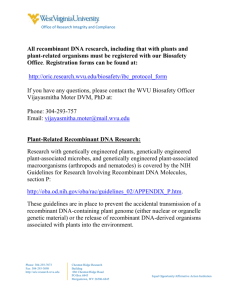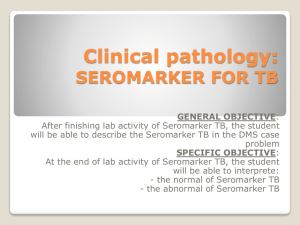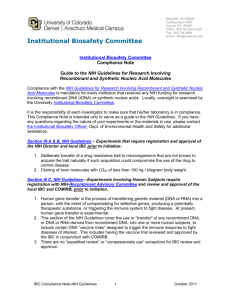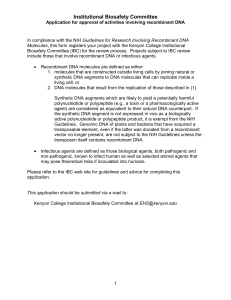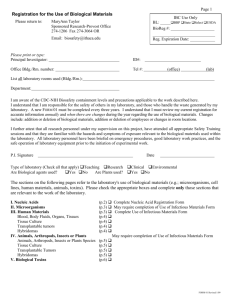IBC Registration Form - Oregon State University
advertisement
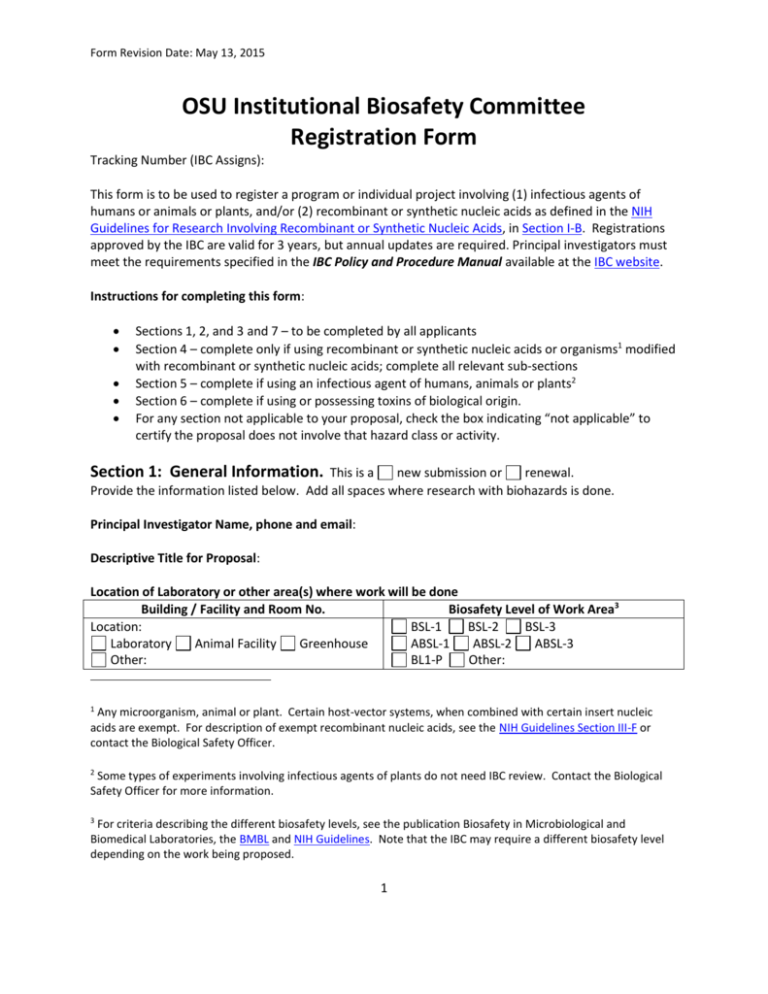
Form Revision Date: May 13, 2015 OSU Institutional Biosafety Committee Registration Form Tracking Number (IBC Assigns): This form is to be used to register a program or individual project involving (1) infectious agents of humans or animals or plants, and/or (2) recombinant or synthetic nucleic acids as defined in the NIH Guidelines for Research Involving Recombinant or Synthetic Nucleic Acids, in Section I-B. Registrations approved by the IBC are valid for 3 years, but annual updates are required. Principal investigators must meet the requirements specified in the IBC Policy and Procedure Manual available at the IBC website. Instructions for completing this form: Sections 1, 2, and 3 and 7 – to be completed by all applicants Section 4 – complete only if using recombinant or synthetic nucleic acids or organisms1 modified with recombinant or synthetic nucleic acids; complete all relevant sub-sections Section 5 – complete if using an infectious agent of humans, animals or plants2 Section 6 – complete if using or possessing toxins of biological origin. For any section not applicable to your proposal, check the box indicating “not applicable” to certify the proposal does not involve that hazard class or activity. Section 1: General Information. This is a new submission or renewal. Provide the information listed below. Add all spaces where research with biohazards is done. Principal Investigator Name, phone and email: Descriptive Title for Proposal: Location of Laboratory or other area(s) where work will be done Building / Facility and Room No. Biosafety Level of Work Area3 Location: BSL-1 BSL-2 BSL-3 Laboratory Animal Facility Greenhouse ABSL-1 ABSL-2 ABSL-3 Other: BL1-P Other: 1 Any microorganism, animal or plant. Certain host-vector systems, when combined with certain insert nucleic acids are exempt. For description of exempt recombinant nucleic acids, see the NIH Guidelines Section III-F or contact the Biological Safety Officer. 2 Some types of experiments involving infectious agents of plants do not need IBC review. Contact the Biological Safety Officer for more information. 3 For criteria describing the different biosafety levels, see the publication Biosafety in Microbiological and Biomedical Laboratories, the BMBL and NIH Guidelines. Note that the IBC may require a different biosafety level depending on the work being proposed. 1 Form Revision Date: May 13, 2015 Location: Laboratory Other: Location: Laboratory Other: Location: Laboratory Other: Animal Facility Greenhouse Animal Facility Greenhouse Animal Facility Greenhouse BSL-1 ABSL-1 BL1-P BSL-1 ABSL-1 BL1-P BSL-1 ABSL-1 BL1-P BSL-2 BSL-3 ABSL-2 ABSL-3 Other: BSL-2 BSL-3 ABSL-2 ABSL-3 Other: BSL-2 BSL-3 ABSL-2 ABSL-3 Other: Decontamination of Wastes: Location of Autoclave used for waste decontamination, if one is used: Location of incinerator4 or vendor, if used: Research Staff: Names and experience level of research staff (level 1 = beginning level; level 2 = novice; level 3 = extensive experience in working with the biohazards identified in this proposal): Principal Investigator: Experience Level: Investigator: Experience Level: Investigator: Experience Level: Investigator: Experience Level: Investigator: Experience Level: List Additional Investigators here and indicate experience levels: General Research Activities Covered in Proposal: This project or program involves (check all that apply): transgenic plants or animals recombinant or synthetic nucleic acids infectious agents of human, animal, or plant infectious agents or recombinant nucleic acids in vertebrate animals human body fluids, cell lines, or unfixed tissues animal body fluids or unfixed tissues Sharps Use: If sharps are to be used, attach a sharps safety SOP or indicate adoption of the OSU Sharps Safety Plan. Sharps SOP specific to the lab or program is attached as a separate document. We will make use of the OSU Sharps Safety Plan, available online here. Section 2: Narrative. Clearly and concisely state the purpose of the research, the general methods to be used during this work to achieve the purpose, and the safety protocols used when handling biological hazards. Do Not: 4 Incineration is required for disposal of pathological wastes, including infected animals and human body parts. 2 Form Revision Date: May 13, 2015 Cut and paste from a grant proposal or IACUC protocol. Duplicate information found elsewhere in this document. Provide a clear idea of the procedures, risks to personnel, environment or agricultural activities. Indicate how any identified risks are minimized by equipment, work practices or other methods. Indicate how biohazardous wastes are handled and disposed of. If protocol involves moving biohazardous materials from one location to another, indicated locations where materials are moved to/from, and how safe transport is to be done. Do: Section 3: Occupational Health. Indicate if persons involved in this work are enrolled in an OSU occupational health program. No occupational health surveillance program(s) Respiratory protection occupational health program (required for any person using a respirator) Animal handler’s occupational health program (required for any person handling animals or exposed to animal secretions, blood or unfixed tissues) Bloodborne pathogen program (required for any person exposed to human cells, blood or body fluids) Tuberculosis testing / surveillance (required for persons who enter the tuberculosis lab) Other (describe): Section 4: Recombinant or Synthetic Nucleic Acids (complete sections below as needed; Indicate not applicable for sections/ responses that do not pertain to your program) For work with recombinant or synthetic nucleic acids, complete the following information about proposed constructs to be created or existing constructs to be utilized in the work. Definition: Recombinant and synthetic nucleic acids are defined as: (i) molecules that a) are constructed by joining nucleic acid molecules and b) that can replicate in a living cell, i.e., recombinant nucleic acids; (ii) nucleic acid molecules that are chemically or by other means synthesized or amplified, including those that are chemically or otherwise modified but can base pair with naturally occurring nucleic acid molecules, i.e., synthetic nucleic acids, or (iii) molecules that result from the replication of those described in (i) or (ii) above. Entire Section 4 is not applicable (stop here). Indicate the Section of the NIH Guidelines that this work falls under: A) Vectors: List and briefly describe the features (antibiotic resistance markers, control elements, trans or cis acting sequences, etc.) of all plasmids, viral vectors, cosmids, or similar elements to be used. Identify any vectors that are conjugative, or if viral vectors, indicate the replication competence status. Attach a spreadsheet if that is more convenient. 3 Form Revision Date: May 13, 2015 B) Hosts: List bacterial, cell culture, plant or animal host organisms into which recombinant nucleic acids will be introduced. C) Insert Nucleic Acid Sequences: List genes or sequences to be engineered into recombinant constructs; include source species of origin, putative or known function of nucleic acid, and whether the sequences are expressed in the host cells. If synthetic, indicate that fact. D) NIH Guideline Checklist: Check any that apply below: Section not applicable. Expression of toxic gene products or molecular cloning of genes for toxins. Release of recombinant or transgenic organisms into the environment. Transfer of antibiotic or other drug resistance to a pathogen, if doing so might compromise the use of the drug therapeutically. (check yes only if this drug is used to treat human or animal infections caused by this organism). Growth of cultures of recombinant organisms in volumes of 10 liters or greater? Recombinant eukaryotic viruses or defective viruses in the presence of helper virus in tissue culture or in live animals. Recombinant constructs with less than 2/3 of the viral genome? E) Transgenic Animals: If work involves transgenic animals, complete this section. Section not applicable. E.1. Type of transgenic animal(s): E.2. Location(s) where animals will be housed: E.3. Gene(s) expressed in transgenic animals, source organism(s): E.4. Control elements (promoters, etc.): Transgenic animals are purchased or transferred from another laboratory; no breeding of transgenic animals is involved. Transgenic animals are created or bred to each other or to non-transgenic animals. If animals are created or bred, describe the features of the transgenes and expression systems. In particular, indicate if either parental rodent or resulting transgenic animal will contain more than ½ of the genome of an exogenous virus: F) Transgenic Plants / recombinant Plant Pathogens: If work involves transgenic plants and/or recombinant plant pathogens, complete this section. Section not applicable. Organism(s) being transformed: 4 Form Revision Date: May 13, 2015 APHIS / PPQ Permit is required for this material (attach a copy). Recombinant organisms are released into the environment. F.1. If this project involves insertion of recombinant or synthetic DNA into a plant to generate stable transformants, or using plants that have already been stably transformed, please complete this section. Section not applicable (go to F.2). Type / species of transgenic plant: This plant is on the Oregon Noxious Weed List (link) or can interbreed with such weeds in the immediate geographic area. Genes or sequences expressed in transgenic plants, functions of the genes or sequences, and source organism: Insert represents the complete genome of an infectious agent: Control elements (promoters, etc.): F.2. If this work involves either inserting recombinant or synthetic nucleic acids into a plant virus, a plant-associated microorganism, or a plant-associated small animal (insect, etc.) or using viruses or organisms that have already been transformed, please complete this section: Section not applicable (go to F.3). The organism being transformed is an exotic infectious agent or microorganism, or an non-exotic microorganism with recognized potential for serious detrimental impact on managed or natural ecosystems. The organism being transformed is a transmissible infectious agent that has the potential of being a serious pathogen for U.S. crops, and is in the presence of specific arthropod vectors. Is a plant-associated small animal, or a microorganism associated with a plantassociated small animal. Genes or sequences expressed in transgenic plants, functions of the genes or sequences, and source organism: Insert represents the complete genome of an infectious agent: Control elements (promoters, etc.): F.3. Transgenic Plants or Plant Pathogens, propagable structures, and facilities used List each transgenic species used in the research project, and (to the right) the corresponding propagable structures (e.g., pollen, seeds), the type of facilities used for each species (greenhouse, growth chamber, etc.) Address the containment strategy for each in the narrative. Depending on the species, several lines may be needed to document propagable structures and facilities. (Alternatively, attach a table or spreadsheet with the same information.) Transgenic Organisms Propagable Structures 5 Facilities Form Revision Date: May 13, 2015 Section 5: Infectious Agents: Complete this section if infectious agents of humans, animals or plants will be utilized in the work. Note that replication defective recombinant viral vectors do not need to be described here. If more convenient, attach a spreadsheet with this information. For information on Risk Groups, see ABSA Database (link). Shipment of infectious agents must conform to DOT and IATA requirements; shipping infectious agents out of the U.S. requires coordination with the OSU Export Control Office. 5.1 General information table. Genus + species; Risk Group Recombinant Status Cells, Animals or Plants Infected? Susceptible Species (check all that apply) Humans Animals Plants Other: Name: Recombinant? Yes No RG-1 RG-2 RG-3 Animals: Plants: Cells: Name: Recombinant? Yes No RG-1 RG-2 RG-3 Animals: Plants: Cells: Humans Animals Plants Other: Name: Recombinant? Yes No RG-1 RG-2 RG-3 Animals: Plants: Cells: Humans Animals Plants Other: Name: Recombinant? Yes No RG-1 RG-2 RG-3 Animals: Plants: Cells: Humans Animals Plants Other: Name: Recombinant? Yes No RG-1 RG-2 RG-3 Animals: Plants: Cells: Humans Animals Plants Other: 5 Scale of Laboratory Culture5 No culture Small scale Intermediate Large scale Other: No culture Small scale Intermediate Large scale Other: No culture Small scale Intermediate Large scale Other: No culture Small scale Intermediate Large scale Other: No culture Small scale Intermediate Large scale Other: Scale of Laboratory Culture: Any propagation of the infectious agent, whether in synthetic media, in live animals or by other methods needs to be indicated. Large scale culture is defined as volumes greater than or equal to 10 L. 6 Form Revision Date: May 13, 2015 Name: Recombinant? Yes No RG-1 RG-2 RG-3 Animals: Plants: Cells: Humans Animals Plants Other: No culture Small scale Intermediate Large scale Other: 5.2. Aerosol Production: most laboratory manipulations generate aerosols. Some procedures have a large potential for aerosol generation and must be done in a certified class I or class II biological safety cabinet. Indicate if any of the following procedures will be performed using cultures of pathogens or other potentially infectious materials. Section 5.2 does not apply. Sonication Performed in a biological safety cabinet. Tissue homogenization or pellet disruption Performed in a biological safety cabinet. Vortexing of open tubes or containers Performed in a biological safety cabinet. 5.3. Antimicrobial Sensitivity. For human pathogens, list antimicrobials the organism is sensitive to that could be used therapeutically to control a laboratory acquired infection. Section 6: Biological Toxins Section 6 does not apply (go to Section 7). General guidelines for toxin use: Toxin acquisition and use should be documented by an inventory system in the lab that allows accurate amounts on hand to be known at all times. If you use any of the toxins on this list, the cumulative amounts must be under the listed limits; also, please contact the Biological Safety Officer for additional requirements before transferring any amount of these toxins to other labs or investigators. Understand what physical or chemical methods are effective for inactivation of any toxin you work with; apply these methods before discard. Vaccines are available for some toxins, such as tetanus or diphtheria toxins; make sure your vaccines are up to date if you work with such toxins. Occupational Medicine is available for consultation and vaccinations. Follow the guidance in Appendix I of the BMBL. Store toxins in a secure location, such as inside a locked freezer or in a locked room. Toxin(s) in use (list): LD50 for toxin(s): Total maximum expected cumulative amount on hand for each toxin: Will toxin(s) be used in live animals? Yes No 7 Form Revision Date: May 13, 2015 Will sharps (needles, etc.) be used with toxins? Yes No Will toxin(s) be purchased from a vendor or purified from biological sources? Describe method of terminal inactivation to be used: Section 7: Statement of Responsibility As Principal Investigator for this project, I have the responsibility to assure that my laboratory operates in a safe manner and that all staff and students are informed of risk, appropriately wear protective equipment, and are adequately trained. I will assure that all students and staff working in my laboratory receive orientation to the OSU Response Guide. I understand that I am responsible for assuring that my laboratory complies with all federal, state, and local environmental laws and regulations. I will comply with shipping requirements for hazardous materials including recombinant and synthetic DNA molecules and infectious agents. If my work involves recombinant or synthetic DNA/RNA molecules, I acknowledge that I am responsible for full compliance with the NIH Guidelines in the conduct of recombinant and synthetic DNA/RNA research. I will neither initiate nor modify any recombinant or synthetic DNA/RNA research until IBC approval is given. I will report the following to the EH&S biosafety officer: (1) Violations of the NIH Guidelines; (2) Biohazardous spills; (3) Loss of biohazard containment; (4) Research-related accidents; (5) Research-related illnesses; (6) Exposures or potential exposures to biohazards, including recombinant or synthetic DNA/RNA; (7) Exposures or potential exposures involving animals previously exposed to biohazards, including recombinant or synthetic DNA/RNA. In case of incidents, I will instruct my staff to complete the Online Accident Report form within 24 hours. To the best of my knowledge, the information reported on this form is correct and accurately reflects my proposed research. I further understand that I must contact the IBC prior to initiating any changes in my research involving infectious agents or recombinant or synthetic DNA/RNA materials. Principal Investigator Name (printed or typed) Date: 8
